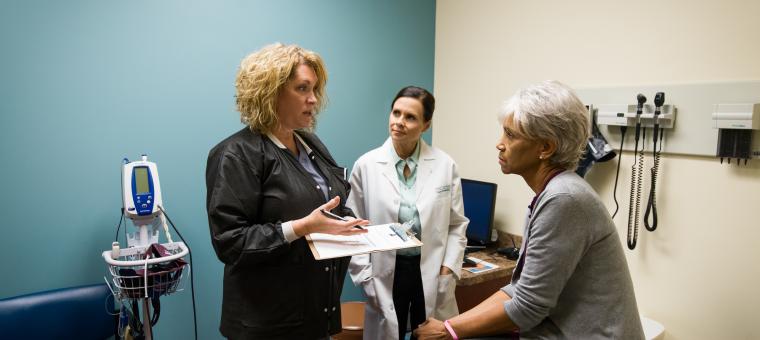« Back to Blog
Diagnostic Imaging and Radiation Therapy Play an Important Role in Cancer Care
I’ve seen great advancements occur over the last several decades in diagnostic imaging and radiation therapy, and today they are vital components of cancer care. Roughly 60 percent of patients undergo radiation and, as technology advances, there may be even more uses for it in the future.
How radiation therapy is used
Radiation therapy is the primary treatment modality in many cancers. Head and neck cancers are a good example. Radiation alone without chemotherapy is highly effective in small and medium sized oropharyngeal and laryngeal carcinomas, preserving voice and swallowing function while treating the cancer.
Similarly, prostate cancer can be successfully treated with radiation. Patients with small cancers, as well as those who have locally advanced prostate cancer, have an increased risk of incontinence and impotence after a radical prostatectomy. By combining hormone therapy, external beam radiation, or internal beam radiation (brachytherapy), continence and erectile function can usually be maintained.
Preoperative therapy is another way to use radiation, and it is typically given with chemotherapy to shrink tumors so that surgery can be more effective. The best example of this is in gastrointestinal cancers when patients have large rectal malignancies. Surgery alone would require removal of the anus and a colostomy. With preoperative chemotherapy and radiation, the tumor can be removed but function is preserved.
Radiation can also play a vital role after surgery. For breast cancer, radiation is almost always used after a lumpectomy to treat potential microscopic extensions of the disease. It is also important for mastectomy patients. Originally, radiation was only recommended for those with four or more positive nodes. However, clinical trials have shown patients with one to three positive nodes may also benefit from it. In other malignancies, like gastrointestinal cancers, radiation is utilized after surgery and chemotherapy to sterilize nodes or extensions of cancer cells.
Lastly, radiation is highly effective for palliation to deal with large tumors obstructing bronchi, pushing on the spinal cord, or growing into bone or nerves, resulting in decreased function or pain.
New technologies are advancing cancer care
The US Oncology Network (The Network) is committed to improving patient outcomes and the patient experience by utilizing promising new technologies, especially highly conformal ones that shape radiation to closely fit the cancerous area while sparing healthy tissue.
The two conformal treatments that are most effective for many cancers are Intensity Modulated Radiation Therapy (IMRT) and Image Guided Radiation Therapy (IGRT). In IMRT, the radiation beam is broken down into hundreds of beamlets of varying strength that, when added together, deliver high radiation to the targeted area, while minimizing exposure to healthy tissue. An illustrative example of IMRT is prostate cancer, where the tumor is wrapped around the rectum, and conventional treatment would impact upon the anterior rectal wall.
In IGRT, an imaging source similar to a CT scanner is connected to the linear accelerator, providing cross sectional images of the tumor. This enables the clinician to very precisely position the patient on the treatment table, ensuring accuracy.
A third technology The Network is focusing on is Stereotactic Body Radiation Therapy (SBRT), a technique that delivers high doses of radiation in very few treatment sessions. Because of the dose strength, clinicians must be absolutely certain they are precisely targeting the tumor, as exposed tissue adjacent to the tumor might be injured by the very high doses of radiation.
The Network is investing substantial time and resources to ensure practices have the appropriate equipment to administer SBRT and that our physicians, physicists, dosimetrists and therapists are properly trained. SBRT is now available in every region across The Network, and our goal is to bring the technology to every radiotherapy center in the organization.
A technology experiencing increased utilization is brachytherapy, a treatment that surgically implants sources containing radioactive material directly into the tumor. Advances over the last decade have made it safer for the clinician to administer this treatment.
Exciting new technologies are under development that will greatly advance cancer care. Magnetic Resonance Imaging (MRI) and PET scanning are both being combined with radiation delivery technologies, enabling better assessment of localization and treatment effectiveness.
Because technologies are changing rapidly, The Network is committed to bringing innovative treatments to patients as soon as they become available.
Technology is not the whole story
Advanced technologies are necessary for successful treatment, but by themselves are insufficient to achieve optimal outcomes. A sharp scalpel is useless unless the person holding it is both well-trained and kind. Radiation oncologists in The Network are continually assessing and improving their quality and expertise. The entire care team must also demonstrate empathy and caring for the patient. One of the wonderful things about being a radiation oncologist today during a time of great technological advancement is the ability to marry care and concern for the patient to advanced technology. I am extremely proud that practices in The US Oncology Network are focused on merging high tech with high touch providing patients and their families the best possible cancer experience.

